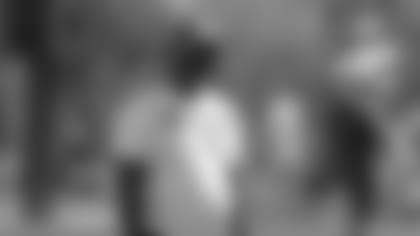With the recent rediscovery of the above photo, how many more times do you think the NFL and others will be bamboozled by it on its next merry-go-round?
It's a picture from what was billed as a Wisconsin high school football championship game played between Marinette and Watertown on Dec. 8, 1917, at Green Bay's Hagemeister Park. One can find a copy of the photo on page 100 of the 1918 Green Bay West High School yearbook, published more than a year before the Packers were founded.
Twelve years ago, the photo was described on the Mears Online Auctions site as the "earliest action image of (Curly) Lambeau known," and also "the earliest known action photo of the Green Bay Packers franchise," and sold for $4,674, including a buyer's premium. Two years later, I wrote a freelance column for the Green Bay Press-Gazette exposing the truth about the picture and, from what I was told, Mears refunded the money.
But it has resurfaced once again and appears in a youtube.com/nfl video titled, "Evolution of Every NFL Team's EVERY Stadium." It's part of an NFL Throwback series. The photo appears 8 minutes 56 seconds into the video, near the beginning of the Packers' segment, and includes a brief narration about their first NFL home, Hagemeister Park.
Showing a photo of a high school football game rather than a 1921 action shot from the Packers' first season in what was then the American Professional Football Association – there are at least two or three Packers action shots available from that season – was certainly a befuddling choice. But beyond that, the Packers never even played in the ballpark in the picture. It was razed in late spring of 1918, roughly six months after the Marinette-Watertown game.
(A copy of the photo with the information that it was a high school football game, and the last football game played at Green Bay's former minor league baseball park appears on page 32 of our four-volume history titled “The Greatest Story in Sports: Green Bay Packers 1919-2019.” The first volume of the set also includes an action photo on page 67 from a 1921 Packers game that would have been a far more appropriate choice.)
Granted, Packers history suffered from three decades of body blows – starting in the 1980s – delivered by writers guilty of slapdash research, wild conspiracy theories and general ignorance of their subject. So, despite the Packers' deep well of colorful and compelling stories, they're not an easy subject to research.
But those mistakes of the past remain too raw to ignore. Thus, for the sake of history, here's a summary of the errors found in the selected "Throwback" videos.
Fourteen seconds earlier in the introduction about Hagemeister Park, the narrator states it was owned by Hagemeister Brewery. Not so. It was owned by the Hagemeister Realty Co. Plus, by 1921, six months before the Packers joined the APFA and because of Prohibition, the former Hagemeister Brewing Co. had started manufacturing ice cream and changed its name to the Hagemeister Food Products Co. While beer might still have been brewed there surreptitiously, that's another story.
That oversight was quickly followed by the narrator explaining the team wasn't "worried if every fan paid to see them play," which may have been true. But, here, the video showed a picture taken in 1941 of fans sitting on a fence overlooking the Packers' practice field east of old City Stadium. Again, a picture exists of fans standing and sitting on tree limbs watching a Packers game from outside Hagemeister Park on page 78 of our four-volume history that would have been a much better choice.
Then comes the segment on Bellevue Park, the Packers' home from 1923-24, where the narrator starts off by referring to it as "a small minor league baseball stadium." Wrong again, just as "Total Football: The Official Encyclopedia of the National Football League" had gotten it wrong in its stadium section when first published in 1997.
A much more reliable source would have been the vignette on Bellevue Park that appeared on page 590 of the Packers 2023 media guide, arguably the most comprehensive in the league.
Green Bay lost its minor league baseball team following the 1914 season after 10 years of play and didn't become home to another until 1940. Actually, that original team played in the same Hagemeister ballpark, where the 1917 high school football game was played. Bellevue Park, on the other hand, was built in less than three weeks in the spring of 1923 to house Green Bay's semipro or amateur baseball team. Five years later, it was demolished.
At the 9:18 mark, the video shows a sketch of old City Stadium, as well as a graphic with the dates that it was home to the Packers, 1925-56. That's 32 seasons, yet the narrator shortly thereafter informs us that it adds up to only 28 seasons.
The video then begins the old City Stadium piece with game action from new City Stadium, which was built in 1957 and renamed Lambeau Field eight years later. The narrator states this move was "historic" because old City Stadium was the "first stadium ever built specifically for the purposes of watching professional football."
The screenshot includes a graphic with the same information and then Jon Kendle, the Pro Football Hall of Fame's vice president of museum and archives, states there was a "high school nearby" and the Packers would dress in the high school, which could only be a reference to the old stadium.
While the video becomes confusing over this span of 18 seconds, from the 9:17 to the 9:35 mark, here in a nutshell is the accurate backstory behind the building of old City Stadium.
First, the funding for the stadium was approved by the Green Bay School Board, and it was built on the grounds of the new Green Bay East High School for the city's two high school football teams. Although Green Bay's mayor at the time, Wenzel Wiesner, used his political clout to help get it built, knowing the Packers couldn't survive in scanty Bellevue Park with its short end zone and other inadequacies, East and West high schools were the primary tenants when old City Stadium was built and their rivalry games would outdraw Packers-Bears games.
New City Stadium, on the other hand, was the one touted for breaking new ground.
On Aug. 3, 1957, the Green Bay Press-Gazette ran an eight-column photo of the not-yet completed stadium with a caption that read: "Officially christened Green Bay City Stadium, it is the only stadium ever built specifically for a professional football team." NFL commissioner Bert Bell championed that claim during "Stadium Dedication Game" weekend, and historians still refer to it in that context today.
As for the Packers dressing in East High when old City Stadium was their home – well, not exactly. The players might have gathered there for a few words before kickoff, but from 1927-35, they dressed in their clubhouse on the top floor of the downtown Columbus Club and bussed to the stadium in their uniforms. In 1936, a small wooden locker room with showers was built under the south stands, and the Packers dressed there through 1956.
Some opposing teams may have dressed in the high school, but the Chicago Bears, the lone annual visitors, would don their uniforms at the Northland Hotel and travel the mile route to the stadium by bus. Other teams did the same, at least at times.
Later comes what the Packers' long-loyal Milwaukee fans might take as a slap in the face.
The narrator begins that segment by telling us the Packers started playing "a few games around the state to attract more fans," and then adds that "their road show," included games at Borchert Field, State Fair Park, Marquette Stadium and Milwaukee County Stadium.
The Packers' first game in Milwaukee was played in 1933 out of necessity. They were in receivership at the time and at risk of folding at any given moment. Thus, they moved their home game against the New York Giants to Borchert Field just three weeks before the game and only two days after receiving a rather foreboding letter from NFL president Joe Carr. The game drew 12,467 fans, the Packers' largest home crowd of the season, and club officials realized they needed Milwaukee to survive.
A copy of the Feb. 19, 1938, league minutes where NFL owners voted unanimously to extend Green Bay's home territory to include Milwaukee is available in the Pro Football Hall of Fame library. Moreover, the Packers media guide shows that five times in the 1940s and as late as 1980, the Packers split their home games evenly between Green Bay and Milwaukee.
Next, let's move on to the video titled, "Evolution of EVERY Team's Logo and Helmet."
The Packers' segment starts with the iconic "G", just shy of one minute into the video. It states: "… the original 'G' was so eye-catching, they had several schools ask to copy it;" and "that they approved its use for Grambling State and Georgia" among others. In truth, there were only two schools where there was evidence that they asked the Packers if they could copy the "G" and were granted permission: Georgia and Greenwood High School in South Carolina.
As so many others have in interviews and printed words, the producers also seemed unaware of the brief relationship between the Packers and the Acme Packing Company. The narrator states that when the Packers joined the league in 1921, they were using an Acme Packing logo that popped onto the screen simultaneously. Here again on page 43 of our media guide, there's a history of the Packers' logos and no Acme Packing logo was included. That's because the one shown in the video was a modern-day creation.
The Packers wore their first logo in 1920, and it was one used by Indian Packing, the company that sponsored them for their first two seasons as an independent team. Here's how the Green Bay Press-Gazette described that logo the day after the Packers' fourth game: "The 'Council Brand' emblem (the name of Indian Packing's main product) was worn on the Packers' jersies(sic) for the first time. The marker sizes up as big as a house and it helps to spot the locals from the opposing gridiron warriors."
In 1921, Acme purchased Indian and sponsored the Packers for less than two months and maybe no more than two weeks. The relationship was short-lived because by the time the Packers played their first league game, Acme was more than $50 million in debt in today's money. And the fact is there was no Acme logo on their uniforms.
Then the video shows a blue "GB" logo, which isn't included in our media guide's logo history, either, because it too was a modern-day creation. The narrator tells us it was introduced in the 1930s, a timeframe when the Packers were wearing blue and known to their fans as the Blues. In addition, the narrator incorrectly ties it to the green "GB" logo that was used from 1959-74 on hats, shirts and jackets, and worn by coaches and other team personnel.
As for uniforms, the Packers switched to a greenish-blue color in 1931 and soon adopted myrtle green – a dark green with a strong greenish-blue tint – as their official color and wore some shade of green through the end of the 1930s, according to a 1980s Clarke Hinkle interview for a public television documentary. By then, use of the name Blues was pretty much ancient history.
As for past Packers uniforms, collectively, here's a summary of how that part of our history became a muddled mess.
It started with the Pro Football Hall of Fame buying into a Packers uniform history created by Maple Leaf Productions, a Canadian company. Maple Leaf produced both a promotional video and a plaque that was sold to the public. The Packers, in turn, included the uniform history in their 2002 media guide.
The uniform re-creations, however, were highly suspect and I was eventually able to share with Sarah Quick, a member of our communications staff since 2002, enough evidence to show that Maple Leaf had gotten either the colors, the information or the dates – and sometimes all of the above – wrong for every Packers uniform it featured through the 1930s.

Included were the supposed 1921-22 Acme Packers uniforms, the 1929-30 first championship uniforms, and the blue and gold-shouldered uniforms at the end of the Curly Lambeau era. Along with my own research, I leaned heavily on the advice of historical photo expert Bill Kapinski and uniform manufacturer Hank Derleth. Kapinski explained how the early development of black-and-white photos could be deceptive. What we think of as lighter colors could actually appear darker than what we think of as dark colors. Derleth built Ripon Athletic into one of the leading manufacturers of NFL uniforms, and he might be unrivaled as a uniform historian. He started working in the uniform business in 1963 for Sand-Knit, a company founded in 1921, and had access and was able to study uniform samples dating to that time period.
Thus, in 2016, our communications staff pulled Maple Leaf's uniform history from our media guide.
In the years since, Brent Hensel, our curator, has created a new uniform history that might be the most striking display in our Packers Hall of Fame. It's still a work in progress because getting uniform colors exactly right for a team that has been in business for more than 100 years requires exhaustive and really never-ending research.
But the bottom line is our Hall of Fame now has an authoritative representation of almost every uniform worn by the Packers, unlike what Maple Leaf and others have recreated.
Over this stretch of the video, there's also a point where the narrator references Gene Ronzani, Lambeau's successor, as "Greg Ronzani." Let's hope, 10 years from now, Vince Lombardi doesn't become Victor Lombardi somewhere in cyberspace.
Then, a little more than four minutes into the video, the narrator revisits the "G." There's far too much to this story to go into detail here, so we'll leave it for another day. But, as a hint, it never mentions the 1969-70 redesign, and the complete and intriguing story behind it.
There was one other video I viewed: "History of NFL's Worst Weather Games: Snow, Rain, Heat, and More." Several Packers games were included and they were relatively mistake-free until the narrative got to the Ice Bowl, where the NFL chose to use its own wind-chill figure and a graphic that focused on myth over truth.
Weather Bureau officials at Austin Straubel Field revealed to the press shortly after the game that the temperature at kickoff had been minus-13 degrees with a wind chill between 46 and 47 degrees below zero. Thus, -13 and -46 are the numbers that the Packers continue to use in the Ice Bowl vignette in their annual media guide.
National Weather Service records show that the temperature ranged from -12 to -14 during the game and was last recorded at -12. NWS has since revised how it determines wind-chill index and under the new formula it shows the wind chill ranged from -33 to -37.
The video tells us the wind chill was -48, which is also how it's listed in the NFL Record & Fact Book, and that the temperature dropped to -15 based on a neon thermometer in downtown Green Bay located near the NFL's headquarter hotel and perhaps shot by a photographer before heading to the stadium.
The numbers might be only slightly different, but it's still a head-scratcher as to why the NFL lists a wind chill in its record book different from National Weather Service records. Plus, the lighted temperature sign figures to have been shot between 9 a.m. and noon, when it did hit -15.
Here is where the myth part comes in: A graphic at the 22:05 mark informs viewers an elderly fan had died in the stands due to exposure to the cold. That was something written about the Ice Bowl in stories long after the fact, but I haven't found it in any official record nor in the Green Bay Press-Gazette's postgame editions. Perhaps I've missed it, but it seems misguided to reference what's likely a falsehood, considering the Ice Bowl produced so many other riveting stories.
I make mistakes. We all mistakes.
But these particular NFL videos have perpetuated far too many falsehoods that we as an organization have corrected over the last several years and done an injustice to Packers history in the process.
The good news is that the NFL pledged Wednesday in a conversation with the Packers that it will rely on our expertise in the future. Let's hope they follow through.














